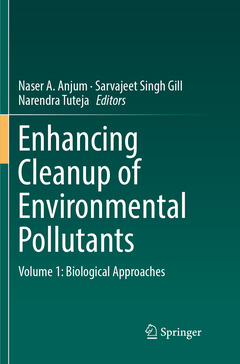Description
Enhancing Cleanup of Environmental Pollutants, Softcover reprint of the original 1st ed. 2017
Volume 1: Biological Approaches
Language: English
Subjects for Enhancing Cleanup of Environmental Pollutants:
Keywords
pesticide contaminated soils; phytoremediation; PAH polluted soils; mineralization of organic contaminants; mine tailings; fly ash dump sites; petroleum hydrocrabons; organic micropollutants; biosorption and bioaccumulation; mycorrhizas; Plant Growth Promoting Rhizobacteria; terrestrial pollution; ecotoxicology
Enhancing Cleanup of Environmental Pollutants
Publication date: 09-2018
Support: Print on demand
Publication date: 09-2018
Support: Print on demand
Enhancing Cleanup of Environmental Pollutants
Publication date: 05-2017
Support: Print on demand
Publication date: 05-2017
Support: Print on demand
Description
/li>Contents
/li>Biography
/li>Comment
/li>
This two-volume work is an effort to provide a common platform to environmental engineers, microbiologists, chemical scientists, plant physiologists and molecular biologists working with a common aim of sustainable solutions to varied environmental contamination issues. Chapters explore biological and non-biological strategies to minimize environmental pollution. Highly readable entries attempt to close the knowledge gap between plant - microbial associations and environmental remediation.
Volume 1 focuses on important concepts such as biological remediation strategies to enhance soil quality at contaminated sites; synergistic influences of tolerant plants and rhizospheric microbial strains on the remediation of pesticide contaminated soil, and the role of plant types such as hyperaccumulator plants in the cleanup of polluted soils. Readers will discover mechanisms and underlying natural inherent traits of various plants and microbes fortolerating, excluding, remediating, accumulating, or metabolizing a variety of pollutants.
Chapter 1. Enhancing the cleanup of environmental pollutants and the role of biological approaches: an introduction.- Chapter 2. Degradation of the dinitrotoluene isomers 2,4 and 2,6-DNT: appraising the role of microorganisms.- Chapter 3. Bioremediation approaches for petroleum hydrocarbons-contaminated environments.- Chapter 4. Bioremediation of polycyclic aromatic hydrocarbons-polluted soils at laboratory and field scale: a review of the literature on plants and microorganisms.- Chapter 5. Organic micropollutants in the environment: ecotoxicity potential and methods for remediation.- Chapter 6. The contributions of mycorrhizas in the mineralization of organic contaminants.- Chapter 7. Remediation of mine tailings and fly ash dump sites: role of Poaceae family members and aromatic grasses.- Chapter 8. Bioremediation of sulfide mine tailings: response of different soil fractions.- Chapter 9. Remediation of polluted soils through hyperaccumulator plants.- Chapter 10. Metal bioaccumulation by plants in roadside soils: perspectives for bioindication and phytoremediation.- Chapter 11. Soil quality protection at heavy metal-contaminated manufactured gas plant sites: role of biological remediation.- Chapter 12. Plant physiology processes associated with ´Plant-Plant Growth Promoting Rhizobacteria´ bioassays for the enhance of heavy metals removal.- Chapter 13. Exploiting nitrogen-fixing rhizobial symbionts genetic resources for improving phytoremediation of contaminated soils.- Chapter 14. Environmental bioremediation by biosorption and bioaccumulation: principles and applications.
Naser A. Anjum is a researcher at CESAM-Centre for Environmental and Marine Studies & Department of Chemistry, University of Aveiro, Portugal.
Dr. Sarvajeet S. Gill is an Assistant Professor at the Centre for Biotechnology, Maharshi Dayanand University in Haryana, India.
Dr. Narendra Tuteja is a Professor and Director of Amity Institute of Microbial Technology (AIMT), Amity University in Uttar Pradesh, India.
Demonstrates the role of plants and microbes in improving soil fertility and function Assists members of the environmental and plant sciences community to keep abreast of developments in terrestrial pollutant minimization Summarizes key recent research on biological approaches employed for cleanup of polluted soils Includes supplementary material: sn.pub/extras
© 2024 LAVOISIER S.A.S.




